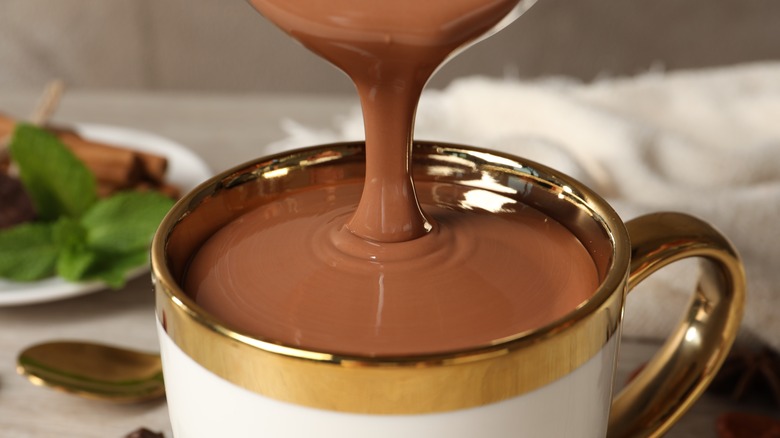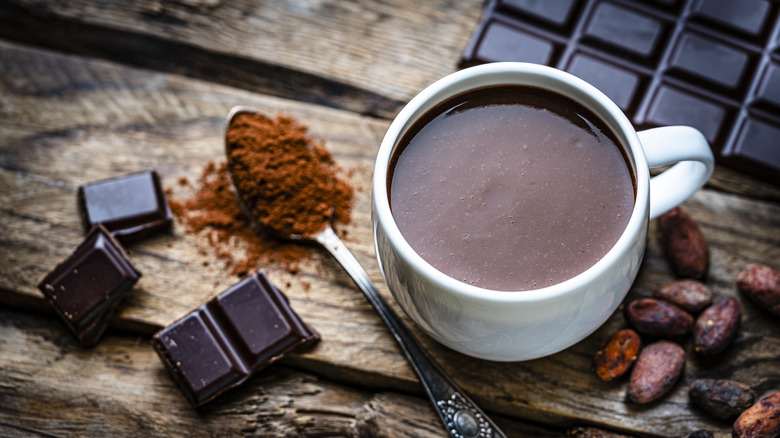Why The French Take Hot Chocolate So Seriously
In the U.S., you'll find a coffee shop of one kind or another on practically every street corner. A morning cup of joe or afternoon pick-me-up is an essential way of life — most everyone has their signature order or their secret to the perfect at-home cup. A beverage like hot chocolate is something that is sipped around a campfire, enjoyed during the holidays, or ordered for the little ones because they shouldn't have caffeine. In France, though, it isn't a drink to be so lightly dismissed — nor is it the same American hot chocolate experience.
It's important to first explain what exactly French hot chocolate is. Chocolat chaud is not made with powder from a grocery store packet. It is made with high-quality melted chocolate and usually whole milk, often with something added like sugar or vanilla. It's a thick, silky, and rich drink to warm a bitter winter day or brighten a morning meal. It is luxurious, but it's a decadence that's quite common within the French culture. To understand hot chocolate's hold on the country, though, it's necessary to go back a few centuries and land at the court of King Louis XIII. Because the reason that the French take hot chocolate so seriously has its origin in the halls of Versailles.
The long history of a sweet drink
Actually, chocolate as a drink goes back much further than that. It began in Mesoamerica around 1900-1500 BCE, when a frothy cacao beverage was part of religious ritual and chronicle. As far as its appearance in Europe, according to the earliest records, the Mayans brought chocolate to Spain in the mid-1500s, transported there by Spanish conquistadors — but the first time it came to France was in 1615, as a gift from Anne of Austria to Louis XIII upon their marriage.
Once introduced, chocolate quickly became a staple of the French royal court for its taste as well as its stimulating and aphrodisiacal qualities. Louis XV enjoyed chocolat chaud so much that he would make it for himself in his chambers. His recipe involved adding one egg yolk to the water and chocolate for richness or whisking an egg white on top for the froth. His mistresses were known to love the drink as well.
In the late 1700s, the infamous Marie Antoinette and her husband, Louis XVI, had two personal chocolate makers, one of which Marie Antoinette brought to the marriage herself (and who was officially titled "The Chocolate Maker to the Queen"). Chocolate was a token of affluence as much as it was truly enjoyed by the royals and their court.
From historical delicacy to modern indulgence
For some time, chocolate remained this delicacy of the wealthy, but thanks to the Industrial Revolution and machine production, it was finally brought to the wider population. In the 1800s, chocolate was produced by Menier, a pharmaceutical company, because it was believed to have medicinal qualities — before the company was sold to Nestle. By then, the popularity of chocolate in France had solidified, from the once-royal courts down through the city streets.
These days, there are cafes all over Paris in quiet chocolat chaud competition, and frequent chocolate consumption is commonplace. According to Statista, nearly 40% of French people consume chocolate regularly, and total chocolate consumption per person was 8.8 kilograms in 2022. Far from just a children's decadent libation, the hot chocolate culture rivals the culture of afterschool snacking in France. And it isn't something you want to miss out on — a proper chocolat chaud recipe will warm you and fill you with a richness passed down through history, even if you aren't drinking it in a Parisian cafe.


